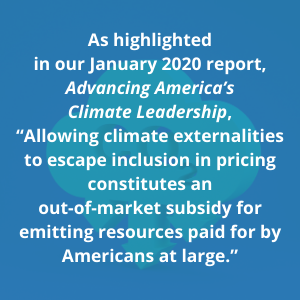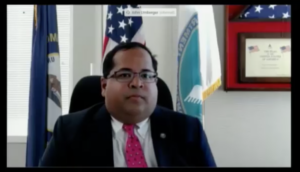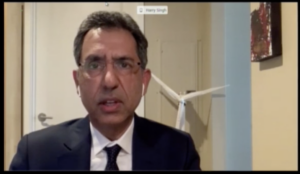Not Your Parents’ Carbon Price: Climate-Aware Wholesale Energy Markets Can Be An Effective, Consensus Part Of the Climate Solution
By: Tyler Stoff
October 7, 2020
Nearly 70% of the nation’s electricity moves through organized wholesale energy markets, where electricity is bought and sold among generators, utilities and traders before reaching end-use customers. These markets are operated by Regional Transmission Organizations (RTOs) and Independent System Operators (ISOs), and regulated by the Federal Energy Regulatory Commission (FERC). Recently, FERC has demonstrated a growing awareness of how the operation of these markets is tied to our climate imperatives.

Approximately one-third of the nation’s greenhouse gases are emitted by the power sector, so sympathetic policies at the RTO/ISO level are vital to ensuring the successful implementation of renewable or clean energy standards. The Federal Power Act requires FERC to enforce “just and reasonable rates” in these markets. ACORE believes that for rates to be just and reasonable, they must internalize the real costs of generation, including the cost of emissions. As highlighted in our January 2020 report, Advancing America’s Climate Leadership, “Allowing climate externalities to escape inclusion in pricing constitutes an out-of-market subsidy for emitting resources paid for by Americans at large.” Earlier this year, Congressman Sean Casten (D-IL) introduced the Energy PRICE Act (H.R.5742), clarifying FERC’s obligation to do just that.
Pricing carbon not only sends market signals to emitting resources that they should retire but also drives investment in new, low-carbon resources by helping them compete. While FERC’s current makeup appears disinclined to affirmatively price carbon in the electricity sector, RTO/ISOs may submit their own carbon pricing proposals for FERC approval at any time. Absent an affirmative FERC decision to price carbon, there are three general theories for why individual RTO/ISOs might price carbon under current law: 1) Doing so will improve market efficiency by internalizing an externality that is directly connected to wholesale rates; 2) Doing so will allow the RTO/ISO to harmonize the operation of their markets with broader state clean energy or climate goals; and 3) Doing so will allow the RTO/ISO to be responsive to direct carbon pricing policies adopted by constituent states.
The California ISO, or CAISO, already utilizes a state-administered form of carbon pricing with FERC approval. Several northeastern states participating in the Regional Greenhouse Gas Initiative, or RGGI, have modest carbon price spillovers in their markets. The New York ISO, or NYISO, may be next with a proposal that would see market bids directly reflect the social cost of carbon through a process administered by the ISO.
In April 2020, ACORE was part of a broad coalition that petitioned FERC to hold a conference on carbon pricing to share our perspective and elicit the Commission’s concerns. ACORE’s President and CEO Greg Wetstone said at the time, “As America’s wholesale power markets weather unprecedented turmoil, thoughtful carbon pricing can serve as an effective complement to state policies like renewable energy standards which are designed to accelerate the transition to pollution-free, renewable power.”

FERC agreed with our petition, organizing a conference on September 30 to discuss the legal and technical intricacies of pricing carbon in wholesale energy markets. The Commission invited three ACORE members to speak, including Harry Singh, Vice President at J. Aron & Company, a subsidiary of Goldman Sachs; Travis Kavulla, Vice President of Regulatory Affairs at NRG Energy; and Laura Beane, Chief Renewables Officer at ENGIE North America. Following are highlights from Chairman Chatterjee’s introductory remarks, as well as ACORE member testimony.
FERC Chairman Neil Chatterjee began the conference by proclaiming, “[O]ur complex energy markets cannot be hermetically sealed from state environmental policies. That’s just an undeniable fact.” After an opening panel on the law, where attorneys and academics universally agreed that FERC had the authority to price carbon – though to different extents – the conference moved on to hearing from market participants.

Harry Singh, a former FERC staffer himself, and now Vice President at J. Aron & Company, a leading trader of electricity in the nation’s wholesale energy markets, walked through the history of carbon pricing proposals and their technical operation. Singh paid special attention to how previous carbon pricing efforts tackled “leakage,” or any change in carbon emissions from resources not covered by the carbon pricing program that occurs as a result of the policy itself. Recognizing the history of the MOPR and resulting uncertainty in energy markets, Singh stated, “Policies that strengthen confidence that organized power markets under the Commission’s jurisdiction can accommodate rather than undo the objectives of state environmental policies will be helpful in promoting the expansion of such markets. The reverse risks producing the opposite effect.”

Travis Kavulla, Vice President at NRG Energy, one of the nation’s largest wholesale sellers of electricity, explained why even power producers with legacy generation assets increasingly want a carbon price that reflects consumer preferences, market trends and state policy goals. Kavulla noted that his company “serves many customers who privately internalize the cost of carbon emissions into their energy purchasing decisions. Some of our large customers do so in explicit financial terms. Our residential customers may not reduce the proposition to a quantification, but many nevertheless choose to purchase all-renewable products or carbon offsets. The desire of our customers to voluntarily purchase such products, together with the improving economics of renewable energy, led my company to make among the largest purchases of new renewable energy of any American company last year, signing 1,600 MWs of solar power purchase agreements. Increasingly, too, states are acting in their sovereign role to price the externality of carbon emissions.” While expressing a preference for a nationwide climate policy, especially to help control leakage, Kavulla also predicted that: “Absent [a nationwide policy], we should expect the number of states adopting such policies and the magnitude of their actions to continue increasing. The diversity of state policymaking on this topic, when it directly affects the regional wholesale electricity markets, is an issue that this Commission must grapple with.”

ENGIE is the largest independent power producer in the world and a prominent renewable developer in the U.S. Their Chief Renewables Officer for North America, Laura Beane, spoke on the conference’s closing panel. Underscoring the basic free market principles of carbon pricing, she testified, “The use of a carbon pricing mechanism at the wholesale level will unleash competitive market forces to provide affordable and reliable supply – in furtherance of the wholesale markets’ mission – while also efficiently meeting state decarbonization goals.” Recalling FERC’s role in creating the nation’s wholesale energy markets, she drove the point home by stating, “FERC has a history of breaking down barriers to market competition….For purposes of integrating carbon pricing into the organized wholesale markets, FERC can do this again. The job ahead is for all of us to work collaboratively on an appropriate mechanism to reduce carbon [and] assist states in meeting their decarbonization goals while preserving grid reliability and wholesale markets.”
Besides ACORE members, more than two dozen other parties spoke in favor of RTO/ISO-level carbon pricing at the conference, or nearly the entire speaker lineup. Carbon pricing advocates included the Natural Gas Supply Association, the right-leaning think tank R Street Institute, and large fossil fuel operators Calpine, LS Power and Vistra.
While FERC has not promised any next steps on carbon pricing, the industry consensus is clear. Moreover, that consensus extends beyond power sector professionals. In what may be the first-ever opinion poll on RTO/ISO-level carbon pricing, Sienna College Research Institute found that 62% of New Yorkers support NYISO’s carbon pricing proposal. An affirmative step from the Commission, like a policy statement on the proper role of carbon pricing in wholesale energy markets or a notice of inquiry to gather more data, would be welcome. However, more concrete action may soon come if FERC is asked to rule on an RTO/ISO request for approval of a new carbon price.
Join leaders from across the renewable energy sector.

What will our next 20 years look like? Here’s the truth: they’ll be better with ACORE at the forefront of energy policy.
Shannon Kellogg
Amazon Web Services (AWS)
